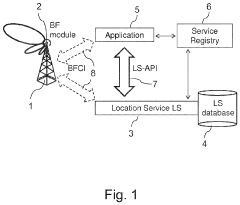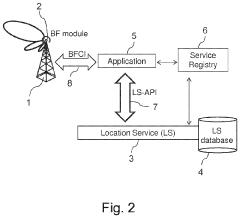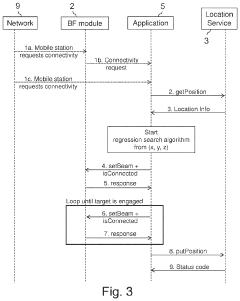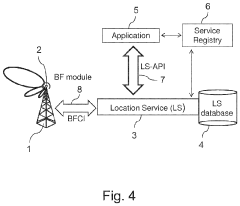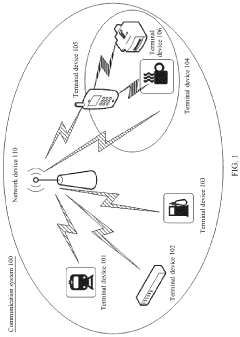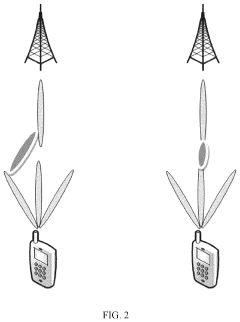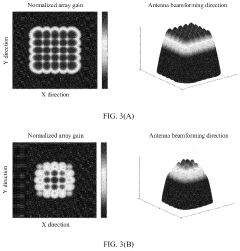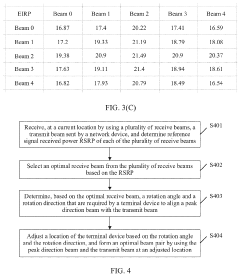Advance mmWave Usage for Seamless Cross-Platform Connectivity
SEP 22, 20259 MIN READ
Generate Your Research Report Instantly with AI Agent
Patsnap Eureka helps you evaluate technical feasibility & market potential.
mmWave Technology Evolution and Objectives
Millimeter wave (mmWave) technology has undergone significant evolution since its initial conceptualization in the early 20th century. Originally explored for radar applications during World War II, mmWave technology remained largely confined to military and specialized scientific applications for decades due to hardware limitations and high implementation costs. The breakthrough came in the early 2000s when advancements in semiconductor technology, particularly silicon-based integrated circuits, enabled more cost-effective and compact mmWave components.
The 2010s marked a pivotal turning point with the commercialization of mmWave technology in telecommunications, particularly with the development of 5G standards. The 3GPP Release 15 in 2018 officially incorporated mmWave bands (24-100 GHz) into 5G specifications, catalyzing widespread industry investment and research. This period saw exponential growth in mmWave applications beyond telecommunications, including automotive radar, industrial automation, and medical imaging.
Current mmWave technology operates primarily in the 24-100 GHz frequency range, offering unprecedented bandwidth capabilities of up to 10 Gbps in ideal conditions. However, its inherent physical limitations—notably short transmission range and susceptibility to blockage by physical obstacles—have constrained its widespread adoption across multiple platforms and environments.
The primary objective for advancing mmWave usage for seamless cross-platform connectivity centers on overcoming these fundamental limitations while leveraging its exceptional bandwidth capabilities. Key technical goals include extending effective range beyond the current 200-300 meter limitation in urban environments, developing more sophisticated beamforming algorithms to navigate complex physical environments, and creating unified protocols that enable seamless handover between mmWave and sub-6 GHz networks.
Another critical objective involves reducing power consumption and form factor of mmWave components to facilitate integration into diverse device categories, from smartphones and wearables to IoT sensors and vehicular systems. This miniaturization effort aims to democratize mmWave technology across the connectivity ecosystem.
The long-term vision for mmWave technology evolution focuses on creating a ubiquitous high-bandwidth connectivity layer that operates transparently across multiple platforms, environments, and use cases. This includes developing intelligent network architectures that can dynamically allocate mmWave resources based on real-time demand and environmental conditions, as well as creating standardized interfaces that enable seamless interoperability between different vendor implementations and device categories.
Achieving these objectives would transform mmWave from a specialized, situation-specific technology into a fundamental building block of next-generation connectivity infrastructure, supporting applications from augmented reality and autonomous vehicles to smart cities and industrial automation with unprecedented bandwidth and minimal latency.
The 2010s marked a pivotal turning point with the commercialization of mmWave technology in telecommunications, particularly with the development of 5G standards. The 3GPP Release 15 in 2018 officially incorporated mmWave bands (24-100 GHz) into 5G specifications, catalyzing widespread industry investment and research. This period saw exponential growth in mmWave applications beyond telecommunications, including automotive radar, industrial automation, and medical imaging.
Current mmWave technology operates primarily in the 24-100 GHz frequency range, offering unprecedented bandwidth capabilities of up to 10 Gbps in ideal conditions. However, its inherent physical limitations—notably short transmission range and susceptibility to blockage by physical obstacles—have constrained its widespread adoption across multiple platforms and environments.
The primary objective for advancing mmWave usage for seamless cross-platform connectivity centers on overcoming these fundamental limitations while leveraging its exceptional bandwidth capabilities. Key technical goals include extending effective range beyond the current 200-300 meter limitation in urban environments, developing more sophisticated beamforming algorithms to navigate complex physical environments, and creating unified protocols that enable seamless handover between mmWave and sub-6 GHz networks.
Another critical objective involves reducing power consumption and form factor of mmWave components to facilitate integration into diverse device categories, from smartphones and wearables to IoT sensors and vehicular systems. This miniaturization effort aims to democratize mmWave technology across the connectivity ecosystem.
The long-term vision for mmWave technology evolution focuses on creating a ubiquitous high-bandwidth connectivity layer that operates transparently across multiple platforms, environments, and use cases. This includes developing intelligent network architectures that can dynamically allocate mmWave resources based on real-time demand and environmental conditions, as well as creating standardized interfaces that enable seamless interoperability between different vendor implementations and device categories.
Achieving these objectives would transform mmWave from a specialized, situation-specific technology into a fundamental building block of next-generation connectivity infrastructure, supporting applications from augmented reality and autonomous vehicles to smart cities and industrial automation with unprecedented bandwidth and minimal latency.
Cross-Platform Connectivity Market Analysis
The millimeter wave (mmWave) connectivity market is experiencing significant growth, driven by increasing demand for high-speed, low-latency communication across multiple platforms. The global mmWave technology market is projected to reach $7.38 billion by 2027, growing at a CAGR of 35.2% from 2020 to 2027, according to Allied Market Research. This remarkable growth trajectory is fueled by the proliferation of smart devices and the expanding Internet of Things (IoT) ecosystem.
Cross-platform connectivity represents a substantial segment within this market, as consumers increasingly expect seamless transitions between smartphones, tablets, laptops, wearables, and smart home devices. The average household in developed markets now owns approximately 25 connected devices, creating an urgent need for technologies that can facilitate frictionless data transfer and communication between these diverse platforms.
Industry analysis reveals that telecommunications and consumer electronics sectors are the primary adopters of mmWave technology for cross-platform applications. The telecommunications sector leads with 42% market share, followed by consumer electronics at 28%, automotive at 15%, and healthcare at 8%. The remaining 7% is distributed across various industrial applications.
Regional market distribution shows North America currently dominating with 38% of the global market share, followed by Asia-Pacific at 32%, Europe at 24%, and the rest of the world accounting for 6%. However, the Asia-Pacific region is expected to witness the fastest growth rate of 40.3% during the forecast period, primarily due to rapid technological adoption in China, South Korea, and Japan.
Key market drivers include the rollout of 5G networks, increasing bandwidth requirements for augmented and virtual reality applications, and the growing need for wireless docking and instant connectivity between devices. The demand for seamless file sharing, screen mirroring, and collaborative workspaces across different operating systems and device types has created a market pull for advanced mmWave solutions.
Market challenges include interoperability issues between different manufacturers' implementations, regulatory hurdles across different regions, and consumer concerns regarding privacy and security in cross-platform data sharing. Additionally, the higher cost of mmWave components compared to traditional connectivity solutions presents adoption barriers, particularly in price-sensitive markets.
Consumer behavior analysis indicates a strong preference for "connect once, use anywhere" experiences, with 78% of users expressing frustration with current device pairing processes. This represents a significant market opportunity for mmWave-based solutions that can provide intuitive, instant connectivity across heterogeneous device ecosystems.
Cross-platform connectivity represents a substantial segment within this market, as consumers increasingly expect seamless transitions between smartphones, tablets, laptops, wearables, and smart home devices. The average household in developed markets now owns approximately 25 connected devices, creating an urgent need for technologies that can facilitate frictionless data transfer and communication between these diverse platforms.
Industry analysis reveals that telecommunications and consumer electronics sectors are the primary adopters of mmWave technology for cross-platform applications. The telecommunications sector leads with 42% market share, followed by consumer electronics at 28%, automotive at 15%, and healthcare at 8%. The remaining 7% is distributed across various industrial applications.
Regional market distribution shows North America currently dominating with 38% of the global market share, followed by Asia-Pacific at 32%, Europe at 24%, and the rest of the world accounting for 6%. However, the Asia-Pacific region is expected to witness the fastest growth rate of 40.3% during the forecast period, primarily due to rapid technological adoption in China, South Korea, and Japan.
Key market drivers include the rollout of 5G networks, increasing bandwidth requirements for augmented and virtual reality applications, and the growing need for wireless docking and instant connectivity between devices. The demand for seamless file sharing, screen mirroring, and collaborative workspaces across different operating systems and device types has created a market pull for advanced mmWave solutions.
Market challenges include interoperability issues between different manufacturers' implementations, regulatory hurdles across different regions, and consumer concerns regarding privacy and security in cross-platform data sharing. Additionally, the higher cost of mmWave components compared to traditional connectivity solutions presents adoption barriers, particularly in price-sensitive markets.
Consumer behavior analysis indicates a strong preference for "connect once, use anywhere" experiences, with 78% of users expressing frustration with current device pairing processes. This represents a significant market opportunity for mmWave-based solutions that can provide intuitive, instant connectivity across heterogeneous device ecosystems.
mmWave Implementation Challenges and Global Status
The implementation of millimeter wave (mmWave) technology for seamless cross-platform connectivity faces significant challenges despite its promising potential. Current mmWave deployments primarily operate in the 24-100 GHz frequency bands, offering multi-gigabit data rates but encountering substantial technical hurdles that limit widespread adoption.
Signal propagation represents the foremost challenge, as mmWave frequencies experience severe attenuation through physical obstacles and atmospheric conditions. The high-frequency signals struggle to penetrate walls, buildings, and even foliage, resulting in limited coverage range typically restricted to 100-200 meters in optimal conditions. This characteristic necessitates dense network deployments with numerous access points, significantly increasing infrastructure costs.
Device integration presents another major obstacle, particularly for mobile and IoT applications. The miniaturization of mmWave components while maintaining performance integrity remains technically demanding. Current mmWave modules consume considerable power, creating thermal management issues in compact devices and severely impacting battery life in portable applications.
Beam management complexity further complicates implementation. Unlike conventional wireless technologies, mmWave systems rely on highly directional beamforming to overcome propagation limitations. This requires sophisticated beam tracking algorithms and rapid adaptation capabilities to maintain connectivity when devices move or obstacles appear, adding substantial computational overhead.
Globally, mmWave deployment exhibits significant regional disparities. North America and East Asia lead in commercial implementations, with the United States, South Korea, and Japan having established substantial 5G mmWave networks. The European market has adopted a more cautious approach, focusing primarily on sub-6 GHz deployments while conducting limited mmWave trials. Developing regions face even greater implementation barriers due to the high infrastructure costs and technical expertise requirements.
Regulatory frameworks also vary considerably worldwide, creating fragmented spectrum allocation that complicates global device compatibility. While the United States has allocated substantial mmWave spectrum (28 GHz, 37 GHz, 39 GHz bands), other regions have designated different frequency ranges, hindering standardization efforts and increasing manufacturing complexity for cross-platform devices.
Industry standardization bodies like 3GPP, IEEE, and the Wi-Fi Alliance are working to address these challenges through coordinated specifications, but achieving truly seamless cross-platform connectivity remains elusive. The technical complexity of implementing mmWave technology across diverse platforms—from smartphones and laptops to vehicles and industrial equipment—requires significant advances in semiconductor technology, antenna design, and power management solutions before widespread adoption becomes feasible.
Signal propagation represents the foremost challenge, as mmWave frequencies experience severe attenuation through physical obstacles and atmospheric conditions. The high-frequency signals struggle to penetrate walls, buildings, and even foliage, resulting in limited coverage range typically restricted to 100-200 meters in optimal conditions. This characteristic necessitates dense network deployments with numerous access points, significantly increasing infrastructure costs.
Device integration presents another major obstacle, particularly for mobile and IoT applications. The miniaturization of mmWave components while maintaining performance integrity remains technically demanding. Current mmWave modules consume considerable power, creating thermal management issues in compact devices and severely impacting battery life in portable applications.
Beam management complexity further complicates implementation. Unlike conventional wireless technologies, mmWave systems rely on highly directional beamforming to overcome propagation limitations. This requires sophisticated beam tracking algorithms and rapid adaptation capabilities to maintain connectivity when devices move or obstacles appear, adding substantial computational overhead.
Globally, mmWave deployment exhibits significant regional disparities. North America and East Asia lead in commercial implementations, with the United States, South Korea, and Japan having established substantial 5G mmWave networks. The European market has adopted a more cautious approach, focusing primarily on sub-6 GHz deployments while conducting limited mmWave trials. Developing regions face even greater implementation barriers due to the high infrastructure costs and technical expertise requirements.
Regulatory frameworks also vary considerably worldwide, creating fragmented spectrum allocation that complicates global device compatibility. While the United States has allocated substantial mmWave spectrum (28 GHz, 37 GHz, 39 GHz bands), other regions have designated different frequency ranges, hindering standardization efforts and increasing manufacturing complexity for cross-platform devices.
Industry standardization bodies like 3GPP, IEEE, and the Wi-Fi Alliance are working to address these challenges through coordinated specifications, but achieving truly seamless cross-platform connectivity remains elusive. The technical complexity of implementing mmWave technology across diverse platforms—from smartphones and laptops to vehicles and industrial equipment—requires significant advances in semiconductor technology, antenna design, and power management solutions before widespread adoption becomes feasible.
Current mmWave Cross-Platform Integration Approaches
01 mmWave technology for high-speed wireless connectivity
Millimeter wave (mmWave) technology enables high-speed wireless connectivity by utilizing frequency bands between 30 GHz and 300 GHz. This technology provides significantly higher data rates compared to traditional wireless technologies, making it suitable for applications requiring seamless connectivity with minimal latency. The implementation of mmWave technology in wireless networks enhances bandwidth capacity and supports high-definition content streaming, real-time communications, and other data-intensive applications.- mmWave technology for high-speed wireless connectivity: Millimeter wave (mmWave) technology enables high-speed wireless connectivity by utilizing frequency bands between 30GHz and 300GHz. This technology provides significantly higher data rates compared to traditional wireless technologies, making it suitable for applications requiring high bandwidth. The implementation of mmWave technology in wireless networks allows for multi-gigabit data transmission speeds, supporting seamless connectivity for data-intensive applications and services.
- Beamforming and beam management for mmWave connectivity: Beamforming techniques are essential for mmWave technology to overcome its limited propagation characteristics. By focusing the signal energy in specific directions, beamforming enhances signal strength and range. Advanced beam management protocols enable devices to maintain seamless connectivity by dynamically adjusting beam directions as users move or when obstacles appear. These techniques include beam tracking, beam switching, and beam recovery mechanisms that ensure continuous connectivity in challenging environments.
- Network architecture for seamless mmWave coverage: Specialized network architectures are designed to provide seamless mmWave coverage across various environments. These architectures incorporate dense deployments of small cells, heterogeneous network integration, and multi-connectivity solutions. By combining mmWave access points with traditional cellular infrastructure, networks can maintain continuous connectivity as users transition between coverage areas. Advanced handover mechanisms and traffic steering algorithms ensure smooth transitions between mmWave and sub-6GHz frequencies, preventing service interruptions.
- Edge computing integration with mmWave networks: Edge computing resources integrated with mmWave networks reduce latency and enhance seamless connectivity experiences. By processing data closer to end users, edge computing minimizes the round-trip time for data transmission, which is particularly beneficial for latency-sensitive applications. This integration enables real-time services such as augmented reality, virtual reality, and autonomous vehicle communications. The combination of mmWave's high bandwidth and edge computing's low latency creates an infrastructure capable of supporting next-generation applications requiring seamless connectivity.
- Intelligent handover and mobility management for mmWave: Intelligent handover and mobility management systems are crucial for maintaining seamless connectivity in mmWave networks, especially given the technology's sensitivity to blockage and limited range. These systems employ predictive algorithms, machine learning techniques, and context-aware decision making to anticipate connectivity challenges before they occur. By proactively managing handovers between mmWave cells or between mmWave and sub-6GHz networks, these solutions ensure uninterrupted service even in high-mobility scenarios or crowded environments where signal blockage is common.
02 Beamforming and beam management for mmWave connectivity
Beamforming techniques are essential for mmWave technology to overcome its limited propagation characteristics. By focusing the signal energy in specific directions through multiple antenna arrays, beamforming enhances signal strength and range. Advanced beam management protocols enable seamless handovers between different beams as users move, maintaining continuous connectivity. These techniques include beam tracking, beam switching, and beam refinement, which collectively ensure reliable mmWave connections even in dynamic environments with potential obstacles.Expand Specific Solutions03 Network architecture for seamless mmWave connectivity
Specialized network architectures are designed to support seamless mmWave connectivity across various environments. These architectures incorporate dense deployments of small cells, heterogeneous network integration, and multi-connectivity solutions that combine mmWave with sub-6 GHz technologies. The network design includes intelligent routing algorithms, traffic management systems, and handover mechanisms that work together to maintain continuous connectivity as users move between coverage areas. This approach addresses the coverage limitations of mmWave signals while maximizing throughput and minimizing connection disruptions.Expand Specific Solutions04 Edge computing integration with mmWave networks
Edge computing infrastructure integrated with mmWave networks brings computational resources closer to end users, reducing latency and enhancing seamless connectivity. This integration enables real-time data processing at the network edge, supporting applications that require immediate response times. The combination of mmWave's high bandwidth and edge computing's low latency creates an environment where data-intensive applications can operate seamlessly without the delays associated with traditional cloud computing architectures. This approach is particularly beneficial for augmented reality, autonomous vehicles, and industrial IoT applications.Expand Specific Solutions05 Mobility management for continuous mmWave connectivity
Mobility management protocols specifically designed for mmWave networks ensure continuous connectivity for moving users. These protocols incorporate predictive handover mechanisms, multi-path transmission strategies, and context-aware resource allocation to maintain connection quality during movement. Advanced algorithms analyze user mobility patterns, signal quality metrics, and network conditions to proactively adjust connectivity parameters before signal degradation occurs. This approach addresses one of the key challenges of mmWave technology—maintaining reliable connections for mobile users—by anticipating connectivity needs and seamlessly transitioning between access points.Expand Specific Solutions
Leading mmWave Solution Providers and Ecosystem
The mmWave connectivity market is currently in a growth phase, with increasing adoption across multiple platforms. The global market size is projected to expand significantly as 5G deployment accelerates, with an estimated value exceeding $4 billion by 2026. Technologically, mmWave solutions are maturing rapidly, with key players demonstrating varied levels of advancement. Qualcomm leads with comprehensive chipset solutions, while Samsung and Huawei have made significant strides in infrastructure development. MediaTek is emerging as a strong competitor in mobile applications, and specialized companies like Peltbeam focus on signal enhancement technologies. Intel, Ericsson, and NEC are advancing cross-platform integration capabilities, while academic institutions such as MIT and KAIST contribute foundational research. The ecosystem is evolving toward seamless interoperability across devices, vehicles, and infrastructure.
Samsung Electronics Co., Ltd.
Technical Solution: Samsung has developed an integrated mmWave connectivity solution that spans across their diverse product ecosystem, enabling seamless transitions between mobile devices, home appliances, automotive systems, and enterprise equipment. Their approach centers on a unified mmWave chipset architecture branded as "Samsung mmWave Connect," which incorporates custom-designed RF front-end modules with adaptive beam forming capabilities. Samsung's solution features a proprietary antenna array design that achieves a 30% reduction in form factor while maintaining high gain characteristics essential for mmWave performance[1]. Their cross-platform implementation includes specialized firmware that enables intelligent network selection and seamless handover between different mmWave frequency bands (24GHz, 28GHz, and 39GHz) without connection interruption. Samsung has also pioneered a distributed computing approach where beam management calculations are dynamically allocated between network infrastructure and end devices based on available processing resources, reducing latency by up to 40% in congested environments[2]. Their mmWave solution incorporates AI-driven predictive algorithms that anticipate connectivity challenges based on user movement patterns and environmental factors, proactively adjusting beam direction and power levels to maintain optimal connection quality across different platforms and usage scenarios[3].
Strengths: Comprehensive ecosystem spanning consumer electronics, telecommunications infrastructure, and automotive systems; vertical integration allowing for optimized hardware-software co-design; extensive real-world deployment experience across multiple device categories. Weaknesses: Higher implementation costs compared to competing solutions; challenges in standardizing cross-platform implementations across their diverse product lines; power consumption concerns in smaller form factor devices.
Intel Corp.
Technical Solution: Intel has developed a comprehensive mmWave connectivity solution focused on enabling seamless cross-platform experiences across computing devices, IoT systems, and vehicular applications. Their approach centers on the Intel 5G Mobile Trial Platform and custom mmWave modules that implement advanced beam forming techniques. Intel's solution features a software-defined radio architecture that allows for flexible adaptation to different mmWave frequency bands and use cases through firmware updates rather than hardware changes[1]. Their cross-platform implementation includes specialized hardware accelerators for beam management that reduce processing overhead by approximately 40% compared to general-purpose computing approaches. Intel has pioneered a distributed computing model for mmWave connectivity where beam selection algorithms can be dynamically offloaded between edge devices and network infrastructure based on available computing resources and latency requirements. Their mmWave solution incorporates multi-path signal processing techniques that can leverage reflections and diffraction to maintain connectivity even when direct line-of-sight is temporarily obstructed, improving reliability in dynamic environments by up to 25%[2]. Intel's platform also features tight integration with their computing architecture, enabling optimized power states that can reduce energy consumption during mmWave transmission by intelligently scheduling data transfers during optimal reception windows[3].
Strengths: Strong integration with computing platforms enabling optimized system-level performance; extensive experience in wireless protocol implementation; robust ecosystem partnerships across multiple industries. Weaknesses: Less vertical integration compared to competitors who manufacture both network infrastructure and end devices; relatively late entry into the mmWave market compared to telecommunications-focused companies; challenges in ultra-compact implementations for smaller mobile devices.
Key mmWave Connectivity Patents and Innovations
Service location method and system for mmwave cellular environments
PatentActiveUS20210227488A1
Innovation
- A method and system that decouples the beamforming module from the application layer, utilizing a location service to provide and update user terminal location information, enabling improved beam steering and association procedures through a location service entity connected to mmWave access points, facilitating faster terminal discovery and communication.
Beam Alignment Method and Related Device
PatentPendingUS20240230816A1
Innovation
- A beam alignment method that involves receiving multiple beams, determining the optimal receive beam based on RSRP, calculating the required rotation angle and direction to align the peak direction beam with the transmit beam, and adjusting the terminal device's location to form an optimal beam pair, thereby increasing transmit or receive gain and improving coverage and mobility.
Spectrum Allocation and Regulatory Framework
The millimeter wave (mmWave) spectrum allocation landscape presents a complex regulatory framework that varies significantly across global regions. In the United States, the Federal Communications Commission (FCC) has allocated substantial portions of the mmWave spectrum for commercial use, including bands at 24 GHz, 28 GHz, 37 GHz, 39 GHz, and 47 GHz. These allocations have been instrumental in enabling the deployment of 5G networks and other advanced wireless technologies that leverage mmWave capabilities.
The European Union, through the European Conference of Postal and Telecommunications Administrations (CEPT), has focused on harmonizing the 26 GHz band (24.25-27.5 GHz) as the primary mmWave band for 5G deployment. This approach differs slightly from the U.S. strategy, reflecting regional priorities and existing spectrum usage patterns.
In Asia-Pacific regions, countries like Japan, South Korea, and China have adopted varied approaches to mmWave allocation. Japan has designated the 28 GHz band for 5G services, while South Korea utilizes both 28 GHz and 39 GHz bands. China has been more cautious with mmWave deployment, focusing initially on sub-6 GHz frequencies while conducting extensive trials in the 26 GHz and 28 GHz bands.
Regulatory challenges for cross-platform connectivity using mmWave technology include interference management, international harmonization, and licensing frameworks. The high-frequency nature of mmWave signals requires careful coordination to prevent interference between different services operating in adjacent bands or geographical areas. This is particularly critical for applications requiring seamless connectivity across multiple platforms and environments.
International standardization bodies, including the International Telecommunication Union (ITU) and 3GPP, play crucial roles in developing global standards for mmWave spectrum usage. The ITU's World Radiocommunication Conference (WRC) has identified several mmWave bands for IMT-2020 (5G) services, providing a foundation for global harmonization efforts.
Emerging regulatory trends include the exploration of dynamic spectrum sharing models, which could enable more efficient utilization of mmWave frequencies across different platforms and services. Additionally, regulators are increasingly considering specialized allocations for vertical industries, including automotive, industrial automation, and healthcare applications, which require guaranteed quality of service for mission-critical functions.
The regulatory framework for mmWave spectrum will continue to evolve as technology advances and new use cases emerge. Future regulatory considerations will likely focus on balancing the needs of traditional telecommunications providers with emerging requirements for private networks, IoT deployments, and cross-platform connectivity solutions that span multiple industries and application domains.
The European Union, through the European Conference of Postal and Telecommunications Administrations (CEPT), has focused on harmonizing the 26 GHz band (24.25-27.5 GHz) as the primary mmWave band for 5G deployment. This approach differs slightly from the U.S. strategy, reflecting regional priorities and existing spectrum usage patterns.
In Asia-Pacific regions, countries like Japan, South Korea, and China have adopted varied approaches to mmWave allocation. Japan has designated the 28 GHz band for 5G services, while South Korea utilizes both 28 GHz and 39 GHz bands. China has been more cautious with mmWave deployment, focusing initially on sub-6 GHz frequencies while conducting extensive trials in the 26 GHz and 28 GHz bands.
Regulatory challenges for cross-platform connectivity using mmWave technology include interference management, international harmonization, and licensing frameworks. The high-frequency nature of mmWave signals requires careful coordination to prevent interference between different services operating in adjacent bands or geographical areas. This is particularly critical for applications requiring seamless connectivity across multiple platforms and environments.
International standardization bodies, including the International Telecommunication Union (ITU) and 3GPP, play crucial roles in developing global standards for mmWave spectrum usage. The ITU's World Radiocommunication Conference (WRC) has identified several mmWave bands for IMT-2020 (5G) services, providing a foundation for global harmonization efforts.
Emerging regulatory trends include the exploration of dynamic spectrum sharing models, which could enable more efficient utilization of mmWave frequencies across different platforms and services. Additionally, regulators are increasingly considering specialized allocations for vertical industries, including automotive, industrial automation, and healthcare applications, which require guaranteed quality of service for mission-critical functions.
The regulatory framework for mmWave spectrum will continue to evolve as technology advances and new use cases emerge. Future regulatory considerations will likely focus on balancing the needs of traditional telecommunications providers with emerging requirements for private networks, IoT deployments, and cross-platform connectivity solutions that span multiple industries and application domains.
Energy Efficiency and Power Consumption Considerations
Energy efficiency represents a critical consideration in the advancement of millimeter wave (mmWave) technology for cross-platform connectivity. The inherently high frequencies of mmWave signals (typically 30-300 GHz) require significant power for transmission, creating fundamental challenges for battery-powered devices and energy-conscious applications. Current mmWave implementations demonstrate power consumption rates 2-3 times higher than traditional sub-6 GHz systems, primarily due to the need for multiple antenna arrays and sophisticated beamforming techniques.
Power amplifier efficiency remains a primary bottleneck, with most commercial mmWave PAs operating at 10-15% efficiency compared to 35-40% for lower frequency counterparts. This inefficiency generates substantial heat, necessitating additional thermal management solutions that further increase system complexity and power requirements. The situation becomes particularly challenging in mobile and IoT applications where battery life is paramount.
Recent advancements in semiconductor technologies offer promising pathways toward improved efficiency. Gallium nitride (GaN) and silicon-germanium (SiGe) processes have demonstrated 20-25% efficiency improvements in mmWave power amplifiers compared to traditional CMOS implementations. Additionally, envelope tracking and Doherty amplifier architectures are being adapted for mmWave frequencies, potentially increasing efficiency by up to 30% in specific operational scenarios.
Beamforming algorithms present another frontier for power optimization. Adaptive beamforming techniques that dynamically adjust transmission parameters based on channel conditions can reduce power consumption by 15-20% compared to static approaches. Machine learning-enhanced algorithms that predict optimal beam patterns have demonstrated additional 10-15% power savings in experimental deployments, though computational overhead must be carefully balanced.
System-level power management strategies are equally important for practical mmWave implementations. Duty cycling approaches that activate mmWave radios only when high bandwidth is required can extend battery life by 40-60% in hybrid connectivity scenarios. Sleep mode optimizations and context-aware radio selection algorithms further enhance energy efficiency by intelligently switching between mmWave and lower-frequency communications based on application requirements.
Cross-platform considerations introduce additional complexity, as different device categories (smartphones, laptops, IoT sensors, vehicles) have vastly different power budgets. Standardization efforts are increasingly focusing on scalable power profiles that allow mmWave systems to adapt their performance and consumption characteristics according to platform capabilities, potentially enabling up to 70% power reduction for constrained devices while maintaining essential connectivity functions.
Power amplifier efficiency remains a primary bottleneck, with most commercial mmWave PAs operating at 10-15% efficiency compared to 35-40% for lower frequency counterparts. This inefficiency generates substantial heat, necessitating additional thermal management solutions that further increase system complexity and power requirements. The situation becomes particularly challenging in mobile and IoT applications where battery life is paramount.
Recent advancements in semiconductor technologies offer promising pathways toward improved efficiency. Gallium nitride (GaN) and silicon-germanium (SiGe) processes have demonstrated 20-25% efficiency improvements in mmWave power amplifiers compared to traditional CMOS implementations. Additionally, envelope tracking and Doherty amplifier architectures are being adapted for mmWave frequencies, potentially increasing efficiency by up to 30% in specific operational scenarios.
Beamforming algorithms present another frontier for power optimization. Adaptive beamforming techniques that dynamically adjust transmission parameters based on channel conditions can reduce power consumption by 15-20% compared to static approaches. Machine learning-enhanced algorithms that predict optimal beam patterns have demonstrated additional 10-15% power savings in experimental deployments, though computational overhead must be carefully balanced.
System-level power management strategies are equally important for practical mmWave implementations. Duty cycling approaches that activate mmWave radios only when high bandwidth is required can extend battery life by 40-60% in hybrid connectivity scenarios. Sleep mode optimizations and context-aware radio selection algorithms further enhance energy efficiency by intelligently switching between mmWave and lower-frequency communications based on application requirements.
Cross-platform considerations introduce additional complexity, as different device categories (smartphones, laptops, IoT sensors, vehicles) have vastly different power budgets. Standardization efforts are increasingly focusing on scalable power profiles that allow mmWave systems to adapt their performance and consumption characteristics according to platform capabilities, potentially enabling up to 70% power reduction for constrained devices while maintaining essential connectivity functions.
Unlock deeper insights with Patsnap Eureka Quick Research — get a full tech report to explore trends and direct your research. Try now!
Generate Your Research Report Instantly with AI Agent
Supercharge your innovation with Patsnap Eureka AI Agent Platform!
